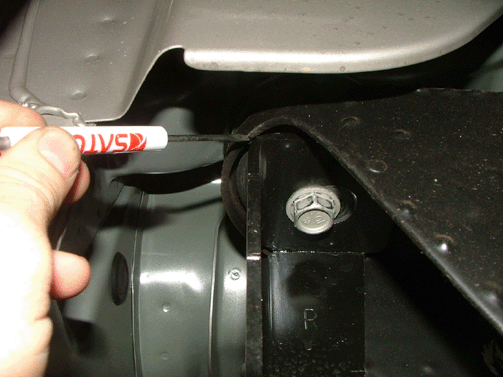For 1990-2009 cars only
Rattle/Clunk Type Noise During Body Twist Maneuvers Or Over Bumps - keywords assist bar contact creak frame metal mount pop squeak step suspension

| Subject: | Rattle/Clunk Type Noise During Body Twist Maneuvers Or Over Bumps |
| Models: | 2001-2007 Chevrolet Silverado Classic |
| 2001-2007 GMC Sierra Classic |
This PI is being created to add models and update correction info. Please discard PIT3089B
The following diagnosis might be helpful if the vehicle exhibits the symptom(s) described in this PI.
Condition/Concern:
Owners may comment of a rattle/clunk type noise coming from the rear of the cab during body twist maneuvers or over bumps. This noise may be coming from the dealer installed GM Tubular Assist Bars(Nurf Bars).
Two areas of concern have been reported:
- The "Gasket" between the Tubular Assist Bar and the body mounting bracket were distorted and the Assist Bar had actually cut through the "Gasket" making contact between the assist bar bracket and body mount bracket. This gasket can be distorted or cut by over tightening the body bolts during installation of the assist bars.
- Metal-to-Metal contact between the assist bar mount bracket and frame. (See Below Picture).

Recommendation/Instructions:
- If the bracket gasket is cut or distorted replace the gasket, which is included in hardware kit 88961680 (brackets, bolts, and washers). Care should be taken when installing the body bolts, DO NOT use an air impact. The bolts should be tightened to spec along with the use of blue Loctite:
- If there is metal-to-metal contact between the assist bar mounting bracket and the body mount frame bracket remove the assist bar and using a file or grinder remove just enought material off the assist bar bracket to provide clearance.
| • | For 2001 and 2005 model year, tighten the bolts to 85 Nm (63 lb ft). |
| • | For 2006 and 2007 model year, tighten the bolts to 100 Nm (74 lb ft). |
Please follow this diagnostic or repair process thoroughly and complete each step. If the condition exhibited is resolved without completing every step, the remaining steps do not need to be performed.
